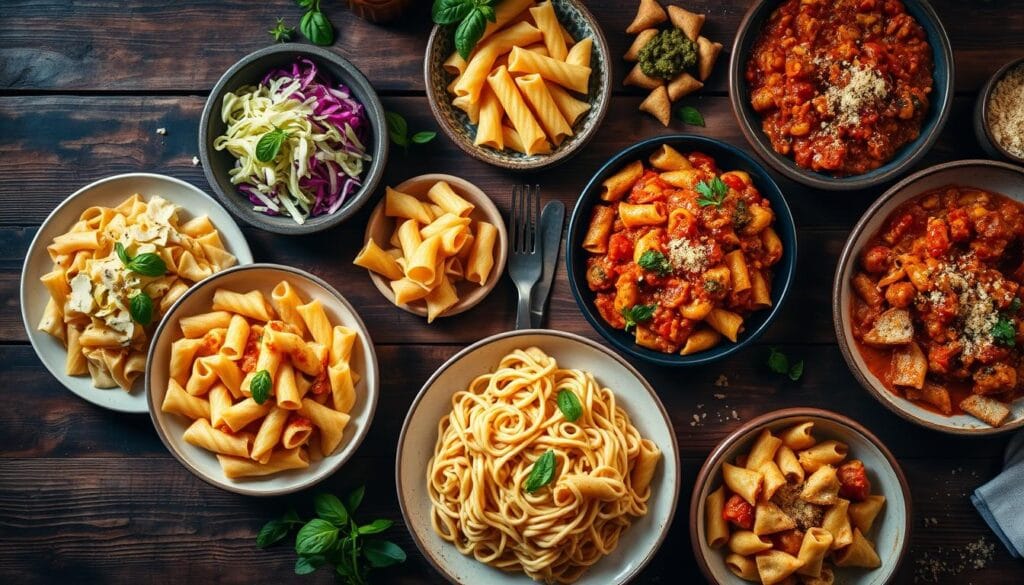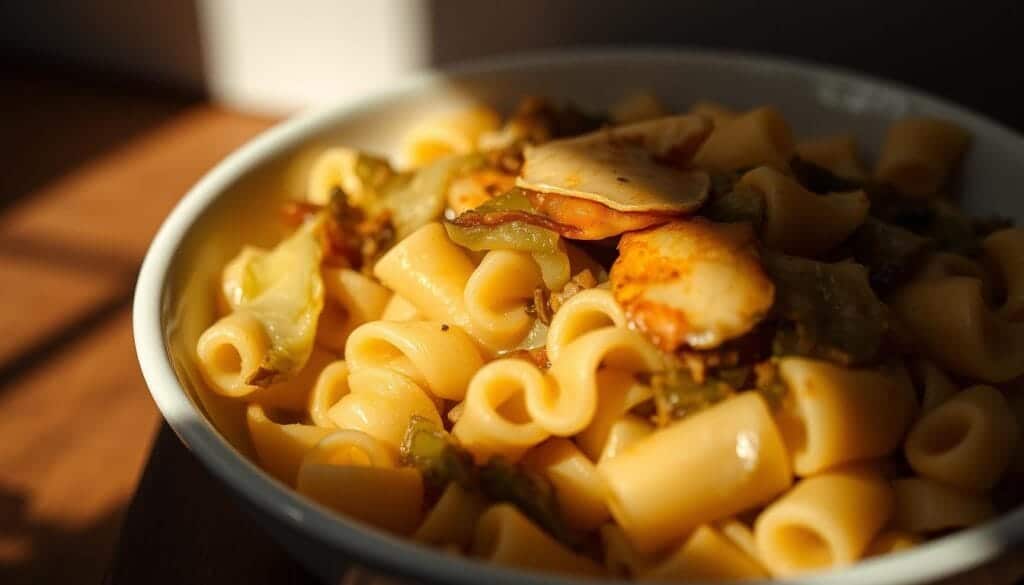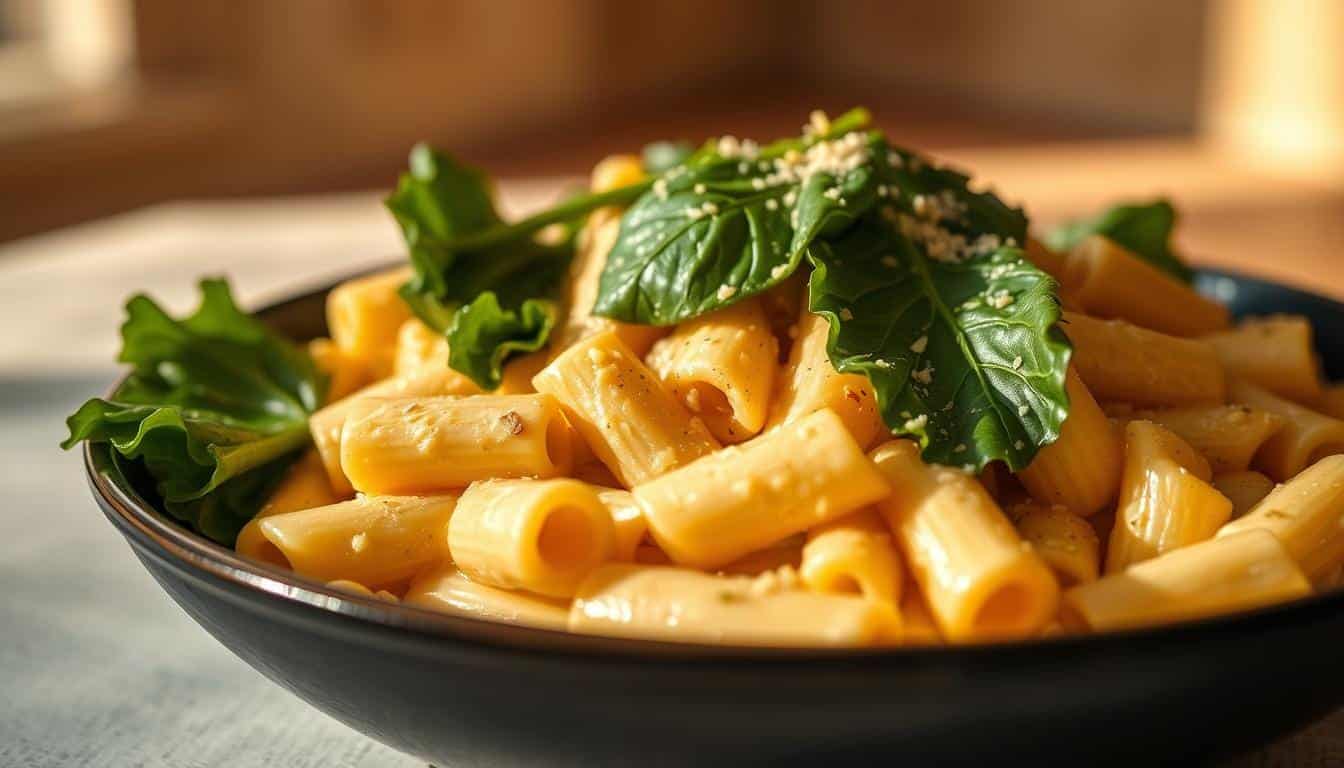This rigatoni with cabbage and fontina feels like a warm hug on a chilly evening. Its buttery cheese, tender pasta, and sweet-savory cabbage layers wrap around you like a cozy blanket. It’s more than just food; it’s a meal that turns quiet weeknights into moments of comfort and shared laughter.
When September arrives, balancing summer’s last tomatoes with fall’s crisp vegetables, this recipe feels like home. It takes just 30 minutes to prep and 60 minutes total. Perfect for busy days when you still crave something special. The 13×9 baking dish fills with golden-brown edges and that familiar aroma of melting cheese, promising a meal that serves 4 people with ease.
Every bite of this pasta dish carries memories: my grandmother’s cabbage recipes, the way fontina melts into something silky and comforting. It’s not just about the ingredients—it’s the joy of sharing something homemade, the warmth of flavors that linger long after the plate is empty. Let’s make this together, shall we?
Introduction to Rigatoni with Cabbage and Fontina
Imagine a dish that combines the warmth of Italian cuisine with the comfort of a classic recipe. This rigatoni dish does just that. It pairs earthy cabbage with the creamy richness of fontina cheese. The first time I made it, I noticed how cabbage’s sweetness complements the cheese’s nutty flavor. It’s a meal that wraps you in warmth on a cold night.
Why This Dish is Unique
This pasta is special because of the cabbage and rigatoni. Caramelized cabbage adds a sweet flavor, while rigatoni holds the creamy sauce inside. It’s a mix of traditional Italian flavors with a comforting twist. This dish is perfect for a cozy night in or a special occasion.
The Benefits of Using Fresh Ingredients
Freshness makes a big difference. Fresh cabbage is crisp and sweet, unlike frozen. High-quality fontina cheese has a tangy, buttery taste that fake cheeses can’t match. Here’s why:
- Fresh cabbage caramelizes evenly, enhancing natural sugars
- Real fontina melts into a velvety sauce without separation
- Quality ingredients cut prep time—no fixing bland flavors
Using fresh ingredients makes this dish stand out. And if you’re in a hurry? Check out these baked dinner tips for quick ways to keep flavors rich.
| Key Ingredient | Quantity | Why It Matters |
|---|---|---|
| Rigatoni | 4 cups | Channels sauce into pasta’s ridges |
| Fontina | 1 lb | Provides umami depth without heaviness |
| Cabbage | 1 medium head | Brings natural sweetness to balance richness |
Every bite tells a story of care. In cooking, small details make a big difference. This recipe needs just 15 minutes of prep but offers hours of comfort.
The Key Ingredients Explained
Every ingredient in this pasta recipe is chosen to create a comforting homemade meal. Let’s break down how each part contributes to the dish’s warmth and flavor.
Rigatoni: The Perfect Pasta Shape
Rigatoni’s tube shape with ridges isn’t just for show—it traps sauce and cheese like a cozy hug. Look for brands like De Cecco or Barilla for sturdy pasta that stays al dente. If unavailable, try cavatappi or fusilli for similar texture.
Cabbage Varieties You Can Use
Savoy cabbage’s crinkly leaves add a tender crunch, while green cabbage offers firmness. Napa cabbage brings mild sweetness. Here’s how to choose:
| Variety | Texture | Flavor | Best Use |
|---|---|---|---|
| Savoy | Crisp | Mild | Stir-fries, soups |
| Green | Firm | Earthly | Salads, stews |
| Napa | Silky | Slightly sweet | Wraps, braising |
“Savoy cabbage adds a delicate crunch to dishes like ribollita.” – Chef Merlin Labron-Johnson
Fontina Cheese: A Flavorful Choice
This Italian cheese melts into velvety silk without getting stringy. Brands like Valais or Aosta Valley Fontina work best. If unavailable, provolone or young Gruyère add similar richness. Always grate it fresh for peak texture.
Pair these ingredients thoughtfully—they’re the heart of this pasta recipe’s soul.
Preparing the Cabbage
Let’s dive into the heart of this vegetarian recipe—the cabbage. This step is key to the dish’s tender texture and sweet taste. Start by picking a crisp Savoy cabbage. Its delicate leaves are perfect for gentle cooking. Here’s how to make it shine:
Best Methods for Cooking Cabbage
- Thinly slice the cabbage into ¼-inch strips for even cooking.
- Pat the leaves dry after rinsing, leaving just enough moisture to steam gently.
- Use a non-stick pan with 2 tablespoons of olive oil—this keeps the cabbage from sticking while preserving its vibrant green hue.
Seasoning Your Cabbage
Seasoning is a quiet art here. Add a single peeled garlic clove to the oil as it heats—its aroma will infuse the dish without overpowering it. Once fragrant, toss in the cabbage and sprinkle with a pinch of sea salt. Let it simmer uncovered for 10 minutes, then cover and reduce heat to low. The gentle steam softens the leaves without turning them mushy.
| Step | Action | Why It Works |
|---|---|---|
| 1 | Sauté garlic in olive oil | Enhances natural sweetness without added fat |
| 2 | Cook uncovered first, then covered | Blends crispness with tenderness |
Remember: This is your easy dinner idea’s backbone. Resist the urge to rush—it takes patience to coax out cabbage’s gentle nuttiness. Once done, set it aside until ready to combine with pasta. Trust me, this step makes all the difference.
Cooking the Rigatoni
When it comes to the pasta dish at the heart of this Italian cuisine masterpiece, patience and precision make all the difference. Let me share the secrets I’ve learned over years of perfecting this technique. Start by boiling a large pot of salted water—enough to fully submerge 1 pound of rigatoni. The water should taste like the sea, so season generously with salt before adding the pasta.
Timing Tips for Perfect Pasta
Set your timer for 1 minute less than the package instructions. Trust me—this pasta will finish cooking in the sauce, ensuring it stays perfectly al dente. I’ve found that rigatoni’s tubular shape holds onto flavors best when slightly undercooked here. Save 1 cup of the starchy pasta water before draining—it’s your secret weapon for binding the dish later.
Tips for Al Dente Texture
Al dente isn’t just a term—it’s the soul of Italian cuisine. Test the pasta by biting into a piece. It should offer gentle resistance but not feel hard. If unsure, check a minute early. Remember, the residual heat from mixing with the cabbage and cheese will continue cooking it. If the pasta seems too firm, add a splash of that reserved water to loosen the sauce.
Always drain the pasta but keep that saved water close by. This step transforms an ordinary pasta dish into something special. Let’s move on to blending everything together in the next section—your taste buds will thank you!
Combining the Ingredients
When rigatoni with cabbage and fontina comes together, every step matters. This homemade meal needs warmth and timing to shine. Let me walk you through how to bring everything together seamlessly.
Layering Flavors for a Tasty Dish
Start by mixing the cooked rigatoni with the sautéed cabbage in a large bowl. Drizzle in 3 tablespoons of béchamel sauce—this is the glue that ties the dish together. Fold in fontina cubes gently. The cheese melts best when everything stays warm. Sprinkle 2 tablespoons of Parmesan on top before baking. Here’s how it comes together:
- Combine rigatoni and cabbage in a bowl.
- Add béchamel and fontina, mixing until cheese softens.
- Transfer to a greased dish and top with Parmesan.
The Importance of Timing
Cheese and heat work best when balanced. Bake at 400°F for 20 minutes—this melts the fontina without drying the cabbage. Let me share timing tips:
| Step | Action |
|---|---|
| Before baking | Ensure cheese is added while ingredients are warm |
| Baking time | 20 minutes at 400°F for golden edges |
| Resting | Let it sit 5 minutes after baking to settle |
Patience here makes all the difference. The result? A dish that’s both comforting and cohesive—a homemade meal worth savoring. Every bite should whisper “I care” to those sharing the table with you.
Variations of the Dish
Let your creativity shine with these easy adjustments to our comfort food recipe. Whether you crave a meaty boost or a plant-focused meal, these tweaks keep the dish cozy and personal—without losing its soul-warming vibe.

- Add 5 oz of crumbled Italian sausage to the pan first, letting it sizzle before the cabbage. Try pancetta or smoked turkey for a lighter option.
- Swap rigatoni for fusilli or penne—twisted shapes trap the cheese better. Use 10 oz of whichever shape you choose.
Meat Add-Ons for Extra Flavor
For carnivores, a savory twist is simple:
- Brown 4 oz of diced bacon first, reserving the fat to sauté veggies.
- Stir in 3 oz of shredded prosciutto halfway through cooking for salty crunch.
Vegetarian Alternatives
Plant-based? Try these upgrades:
- Stir ½ cup toasted pine nuts into the cheese sauce for richness.
- Sauté 8 oz of sliced mushrooms with the cabbage for earthy depth.
- Add ¼ tsp smoked paprika to the béchamel for a smoky twist.
Play with seasonings too—grated nutmeg or a squeeze of lemon juice brighten winter meals. Keep the mission of this pasta recipe in mind: adapt, enjoy, and make it yours.
Serving Suggestions
Let your rigatoni rest for 5 minutes after baking. This ensures the cheese stays gooey and the flavors blend well. This Italian recipe is easy to make and feels special with a few touches. For the full recipe, check out this guide. Serve it with:
A little contrast makes a big difference. Try these additions to make your meal better:
Perfect Pairings for Rigatoni
- Arugula salad tossed with lemon and olive oil—its peppery bite cuts through the creaminess.
- Crusty Italian bread for mopping up cheese and sauce.
- Roasted cherry tomatoes or sautéed mushrooms for a veggie boost.
For a cozy touch, serve the dish family-style straight from the oven. The golden crust stays melty longest when shared from one warm dish. Pro tip: Garnish with fresh herbs like parsley just before serving—this adds freshness to every bite.
Storing Leftovers

Leftovers can be just as comforting the next day. This rigatoni with cabbage and fontina is a perfect example. As a vegetarian dish, its flavors get even better with time. To keep it perfect, just follow these simple steps:
Best Practices for Refrigerationation
- Cool the dish completely uncovered to avoid sogginess.
- Transfer to airtight containers. Glass keeps the fontina from absorbing plastic smells.
- For freezing: Assemble the uncooked mixture in freezer-safe bags. Label with dates and thaw in fridge overnight before baking.
Reheating with Love
Bring back that first-batch magic with these tips:
- Oven method: Bake at 325°F for 15-20 minutes, coveredd with foil. Add a splash of broth before reheating to revive moisture.
- Stovetop: Simmer a portion in a skillet with 1-2 tbsp broth. Stir gently to keep the rigatoni from clumping.
- Freezer batches: Portion into single servings. Freeze raw, then bake directly from frozen—add 15 extra minutes to the original recipe’s time.
Leftovers can feel like a gift, especially with this vegetarian recipe. Its creaminess stays just as good as the first day. Keep these tips in mind, and your rigatoni with cabbage and fontina will comfort you for days.
Nutritional Facts
Let’s explore what makes this comfort food recipe both nourishing and satisfying. Every meal should feel like a warm hug for your body. This pasta dish brings that warmth without sacrificing anything.
- Calories: 540—perfect for a hearty meal that keeps you fueled.
- Protein: 21g—thanks to cheese and pasta’s blend of plant-based and animal protein.
- Fiber: 5g from cabbage’s crisp texture.
- Key vitamins: Vitamin C and K from cabbage, plus calcium from fontina.
Caloric Balance at a Glance
This dish balances hearty ingredients into a nourishing whole:
- Pasta: 200 cal (carbs for energy)
- Cabbage: 22 cal (rich in antioxidants)
- Cheese: 110 cal (adds creaminess and nutrients)
Nutrition’s Hidden Gems
Cabbage is packed with folate and manganese—boosting your immunity. Fontina’s calcium supports strong bones without too much fat. Plus, the olive oil in this recipe is full of heart-healthy unsaturated fats!
“Nutrition doesn’t have to mean sacrifice,” we believe. Enjoy this dish mindfully—pair it with a green salad for extra veggies.
Remember: Adjust salt to your preference to keep sodium levels balanced. This comfort food recipe shows that cozy meals can still be good for your body.
Conclusion
This dish is more than just a meal; it’s a celebration of simple ingredients coming together. It’s ready in under an hour, making it perfect for busy nights or cozy gatherings. With creamy fontina, crisp-tender cabbage, and hearty rigatoni, every bite feels like a hug from the kitchen.
Final Thoughts on Rigatoni with Cabbage and Fontina
This recipe shows the beauty of balance. The cabbage’s earthiness, pasta’s comforting weight, and cheese’s richness nourish both body and spirit. It uses pantry staples like mozzarella and Dijon mustard, making it easy to make. It can be baked in a skillet or casserole dish, adapting to what you have on hand.
Encouragement to Try the Recipe at Home
Give this recipe a try—your kitchen (and dinner table) will thank you. Swap cheeses if needed, add a dash of chili powder for warmth, or serve with a green salad to lighten it up. Leftovers keep well, making it a smart easy dinner idea for busy weekdays.
When you take that first forkful, I hope you’ll taste the same joy I do. The kind of flavor that reminds us why homemade meals matter. It’s the little details—the melted cheese, the cabbage’s gentle sweetness—that turn ingredients into memories. Let this recipe be your next kitchen adventure. Your family’s next cozy meal starts here.
FAQ
Can I use a different type of pasta for this recipe?
Absolutely! You can use penne or ziti instead of rigatoni. Make sure the pasta can hold onto the cheese and cabbage flavors.
What if I can’t find fontina cheese?
If you can’t find fontina, try provolone or young Gruyère. They’ll add a unique flavor, but the texture might be different.
Can I make this dish vegan?
Yes! Use a vegan cheese alternative that melts well. Add sautéed mushrooms and nuts for extra flavor and texture.
How do I store leftovers properly?
Cool the dish completely before storing it in an airtight container. It lasts up to 3 days in the fridge. Freeze in portions for easy thawing.
How can I incorporate more vegetables into this dish?
Add sautéed mushrooms, spinach, or roasted red peppers. They’ll boost the flavor and nutrition.
Can I prepare this dish ahead of time?
Yes, cook the pasta and sauté the cabbage earlier. Assemble and bake just before serving for a melty cheese.
What is the best way to reheat leftovers?
Reheat in a 325°F oven, covered with foil for 15-20 minutes. Or warm gently on the stovetop with a bit of water. This keeps the cheese creamy.
We are interested in your feedback
There are no reviews yet. Be the first one to write one.

